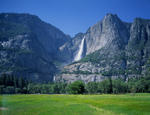La Casa Nevada
For fifteen years after the coming of visitors, the wonders of the Merced Canyon above Happy Isles were
accessible only to those hardy mountaineers who could scramble through the boulder-strewn gorge without
the advantage of a true trail. In 1869-70 one Albert Snow completed a horse trail front Yosemite Valley to the
flat between Vernal and Nevada falls, and there opened a mountain chalet, which was to be known as “La
Casa Nevada.” The popularity of the saddle trip to the two great falls of the Merced was immediate, and the
pioneer trail builder, John Conway, extended the trail from Snow’s to Little Yosemite Valley the next year. It
then was usual for all tourists to ascend the Merced Canyon to La Casa Nevada and Little Yosemite. Some
hikers undertook the trip from Little Yosemite to Glacier Point, but another fifteen years were to elapse before
Glacier Point was made accessible by a truly good horse trail from Nevada Fall.
Snow’s was opened on April 28, 1870. One of the prized possessions of the Yosemite Museum is a register
from this hostelry, which dates from the opening to 1875. Upon its foxed pages appear thousands of
registrations and numerous comments of more than passing interest. Among these is a very interesting
two-page manuscript by John Muir, describing an 1874 trip to Snow’s via Glacier Point and the Illilouette. P.
A. H. Laurence [Editor’s note: James Henry Laurence—dea], once editor of the Mariposa Gazette,
contributed to its value by inscribing within it an account of his visit to Yosemite Valley in 1855, years
before the chalet was built.
A party with N. H. Davis, United States Inspector General, commented upon their destination and added:
“This party defers further remarks until some further examinations are made.” Under the date of the original
entry is a significant second autograph by a member of the General’s party: “A preliminary examination
develops an abundance of mountain dew.”
A great pile of broken containers, which had once held the “mountain dew,” is about the only remnant of La
Casa Nevada which may be viewed by present-day visitors, for the chalet was destroyed by fire in the early
’nineties.


 between Vernal and Nevada Falls. If you can locate some of the stories of their years up there, they are highly amusing. Two of my favorite were that you could find 11 feet of snow at that location; Harold was 6' tall and Emily 5'. The other that I have personally adopted is that Emily would serve pork and beans with meals, along with the remark, "Here, have some more 'strawberries.'" I don't recall the details of why they ended the venture - possibly a death - but the structures were abandoned and eventually burned about 1896. In the summer of 1969, the Sierra Club hauled out many bags of refuse from the hotel days. I just consulted my edition of Russell's "100 Years in Yosemite," and there is a nice picture of the structures in it. I believe there have also been a number of smaller structures in Little Yosemite Valley, but I don't have any definitive knowledge of them.
between Vernal and Nevada Falls. If you can locate some of the stories of their years up there, they are highly amusing. Two of my favorite were that you could find 11 feet of snow at that location; Harold was 6' tall and Emily 5'. The other that I have personally adopted is that Emily would serve pork and beans with meals, along with the remark, "Here, have some more 'strawberries.'" I don't recall the details of why they ended the venture - possibly a death - but the structures were abandoned and eventually burned about 1896. In the summer of 1969, the Sierra Club hauled out many bags of refuse from the hotel days. I just consulted my edition of Russell's "100 Years in Yosemite," and there is a nice picture of the structures in it. I believe there have also been a number of smaller structures in Little Yosemite Valley, but I don't have any definitive knowledge of them.

